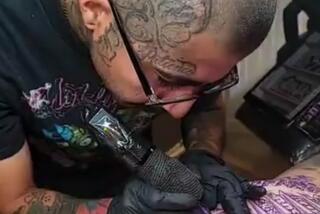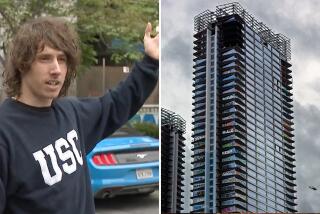Daniel N. Finegood, 52; prankster known for creative alterations of Hollywood sign
The first time Danny Finegood played a word game with the Hollywood sign, he hung curtains to make it read Hollyweed. That was Jan. 1, 1976 -- the day the state’s relaxed marijuana law took effect.
The prankster and friends obscured consonants to coin Holywood for Easter later that year and Ollywood to protest the hero worship of Marine Lt. Col. Oliver North during the Iran-Contra hearings in 1987.
In his final round of wordplay, Finegood made a political statement against the Persian Gulf War by draping plastic sheeting over the 50-foot-high letters to form Oil War in 1990.
Finegood, who viewed his hillside handiwork as environmental sculpture, died of multiple myeloma Monday at Hollywood Presbyterian Medical Center, said his wife, Bonnie. He was 52.
Growing up in the shadow of the hillside landmark, Finegood had developed affection for the letters first erected in 1923 to promote a housing development.
As an art major at Cal State Northridge, he first made mischief with the sign for a class project that involved working with scale.
“For a long time, he had this idea that if you just changed the two O’s you could change the whole meaning of the sign,” his wife said.
He made a scale model, enlisted three friends to help and spent about $50 on materials.
Using only stones and rope, they hung the sheets as if they were hoisting sails, his wife said.
“His parents were up early that morning to catch it. They were very proud that Danny had thought up this,” Bonnie Finegood said.
The media -- alerted to the alphabetic tinkering the night before -- were also there. The Hollyweed image was seen around the world.
The stunt earned him an A on the class assignment.
Years later, he protested a characterization of the incident in The Times that referred to “vandals” altering the sign.
“We broke no laws and did no damage to the sign,” Finegood and friends wrote in a 1983 letter to the newspaper.
“An artist’s role throughout history has been to create representations of the culture he exists in. By hanging four relatively small pieces of fabric on the landmark, we were able to change people’s perception of the Hollywood Sign,” they wrote.
Almost no one saw his final sign tampering. After Finegood and cohorts climbed Mt. Lee before dawn and made the sign say Oil War, park rangers and police yanked down the plastic before sunrise.
Tired of what they saw as vandalism -- the sign had been altered by others several more times -- city officials beefed up security with a fence, alarms and eventually installed a closed-circuit surveillance system.
With the increased security, “it was clear they wanted to keep people away from the sign,” and Finegood decided to respect that, his wife said.
Daniel Ned Finegood was born March 23, 1954, in Los Angeles to David Finegood, who owned a furniture-making company, and his wife, Rachel.
As a teenager, he began building a collection of neon signs that included the Pontiac chieftain that once heralded a Westside car dealership and a 20-foot-high dragon from a Chinese restaurant.
While pursuing a bachelor’s in fine art, he attended Santa Barbara City College and Cal State Northridge but graduated from Immaculate Heart College in Los Angeles.
At LeConte Junior High, he met his future wife, but they didn’t seriously date until college. They weren’t seeing each other when she caught the end of a TV news report about the Hollyweed sign. Soon Danny Finegood was at her door.
“He smiled and said, ‘Do you like what I did?’ I said, ‘Oh my god. You did that?’ That was it. That clinched our relationship,” she said.
They married in 1979 and Finegood joined his family’s furniture business, eventually taking over the company.
He sold Hollyweed T-shirts through ads in High Times magazine, and posters through his website, hollyweed.net.
Other ideas for manipulating the sign remained unrealized.
He thought it should say Hollyween on Oct. 31 and wanted to camouflage the sign for April Fool’s Day to make it seem as if it had vanished.
In addition to his wife and mother, Finegood is survived by his children, Matthew and Natalie; and sister Freddi Sue Finegood.
Donations may be made in Finegood’s memory to the Institute for Myeloma & Bone Cancer Research, 9201 W. Sunset Blvd., Suite 300, West Hollywood, CA 90069.
More to Read
Sign up for Essential California
The most important California stories and recommendations in your inbox every morning.
You may occasionally receive promotional content from the Los Angeles Times.











